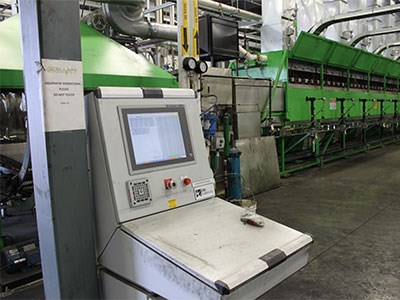A tire-recycling facility in Sault Ste. Marie is moving forward to the next phase of operation, with commercialization anticipated within the year.
Ellsin Environmental, which set up a pilot plant in the city in 2011, has been testing its patented reverse polymerization technique for the last three years.
The process breaks down used tires into its three basic elements—carbon black, oil and steel—which can then be sold to various markets.
President and CEO Daniel Kaute said the plant can currently process 900 tires a day, but the project can be scaled to serve a higher capacity of tires without risk.
He’s currently working on securing buyers for the byproducts, and said he is in negotiations for agreements with 15 parties.
“We have about four MOUs (memorandums of understanding) with various parties across the world— one in the Middle East, one in North America, one in China and one in Europe—and we’re working with these parties,” Kaute said. “We are hoping to get into contract negotiations with the first one very soon, so within three to six months, we should hopefully have a contract in hand and the rest will be history.”
While other tire-recycling plants exist, Kaute said what makes Ellsin’s unique is the ability for investors and prospective buyers to see the operation in action.
Plant manager Clint Wardlaw routinely takes visitors through the plant, where they can learn about the equipment and see it operating on site.
Some clients view the equipment as a self-contained mechanism for disposing of used tires, while others are interested in the machinery as an add-on to an existing business.
“So far we’ve done a 50- hour run, complete, without a problem,” Wardlaw said. “Next, we’re going to do a 150-hour run, just to prove to people that are interested that it runs and it can run for a week, 10 days, or around the clock.”
Tires travel along a conveyor belt, where they’re fed into an enclosed system and processed by microwaves. Water acts as a separator, separating the carbon black and steel into various containers.
A condenser on site draws off the vapour produced by the process and separates the oil into its own container, while the vapours go into a scrub area, are scrubbed of sulfur and then directed into a compressor.
The resulting syn-gas is then used, in combination with natural gas, to run the plant, and any extra is sold back to the grid.
“So, basically, from the tire going in, back around to the generator, every part of the tire is used or processed and there are no scraps leftover,” Wardlaw said.
Finding buyers for the plant’s byproducts is something Kaute is working on right now. While other clean-tech firms rely on government subsidies to keep it running, Kaute noted that Ellsin has relied on its investors for more than 20 years and will soon be able to generate revenues from the sale of the plant’s byproducts.
Carbon black makes up about 70 per cent of the value, he said, and he’s currently working with a number of companies that have expressed interest in it.
Of the product, 60 per cent goes back into tires, 20 per cent goes into automotive rubber of the kind used for weather stripping, 10 per cent goes into other rubber products, and the final 10 per cent is used for specialty products like activated carbon used for filtering
out toxins from the affluent that’s a result of incineration.
“The key, which I’m doing right now, is that I am working on finding offtake agreements for our byproducts, and the moment I have those offtake agreements for our carbon black, oil and steel, we have a business case and we can run the factory profitably,” Kaute said. “There are still a few things we can add to the factory, but we’re very close to being able to do that. So within a year, I want to see the factory running profitably.”
The province generates 1.4 billion used tires per year, but the recycling market is closely monitored by the Ontario Tire Stewardship (OTS), which metes out tire allotments to recyclers across the province. The OTS has diverted more than 53 million tires from the province’s landfills since the program’s inception in 2009.
To be eligible for a tire allotment, Ellsin had to prove that it has adequate offtake to recycle tires, but Ellsin needed tires to be able to produce the byproducts and prove it had offtake; something Kaute calls a chicken-and-egg scenario. But, the company has been working with the Ministry of the Environment to remedy the situation.
“The Ministry of the Environment has been very co-operative and has allowed us to take tires not only from Ontario, but from the U.S. and other provinces as well, and with that we have been able to find the tires that we need to do the trials,” Kaute said. “Once we’re fully settled, once we have our offtake agreement, then that is not going to be a problem anymore. Then we are within the limits of what the OTS wants and we’ll have tires.”




